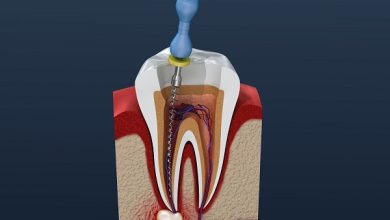Discover the Fascinating Transformation: Dental Implant Demystified
A dental implant before the crown looks like a small, titanium screw placed in the jawbone.
Chapter 1: Understanding Dental Implants
Dental implants are a popular solution for replacing missing teeth. They consist of three main components: the implant itself, the abutment, and the crown. The implant is a small titanium post that is surgically placed into the jawbone. It acts as the root of the new tooth. The abutment is a connector placed on top of the implant, which supports the crown. The crown is the visible part of the dental implant that resembles a natural tooth.
What Are Dental Implants?
Dental implants are artificial tooth roots that provide a strong foundation for replacement teeth. They are designed to look, feel, and function like natural teeth. Dental implants can be used to replace a single tooth, multiple teeth, or even a full set of teeth.
The Significance Of Dental Implants
Dental implants offer several advantages over other tooth replacement options. They provide a long-lasting solution, as they are designed to fuse with the jawbone and become a permanent part of your smile. Dental implants also help to preserve the integrity of the jawbone and prevent bone loss, which can occur when a tooth is missing. Furthermore, dental implants allow you to eat, speak, and smile with confidence, as they are stable and secure.
How Dental Implants Work
The process of getting dental implants typically involves multiple steps. After a thorough evaluation, including X-rays and a dental exam, the implant is surgically placed into the jawbone. Over time, the implant fuses with the bone through a process called osseointegration. Once the implant has healed, an abutment is attached, and then a custom-made crown is placed on top to complete the restoration. With proper care, dental implants can last a lifetime.
Chapter 2: The Benefits Of Dental Implants
Dental implants not only have the ability to replace missing teeth with a natural-looking crown, but they also offer a range of benefits. The restoration of function and aesthetics is one such advantage. A dental implant, before the crown placement, consists of a titanium post that integrates with the jawbone to provide a strong and stable foundation. This allows for proper chewing and speaking abilities, restoring the natural function of the teeth.
Additionally, dental implants contribute to enhanced oral health and hygiene. Unlike traditional bridges, they don’t require altering adjacent teeth for support, keeping the surrounding teeth intact. This promotes better oral hygiene practices, with no difficulty in flossing or cleaning around the implant. Moreover, dental implants stimulate bone growth, preventing bone loss and preserving facial structure.
Another significant benefit of dental implants is the boost they offer to self-confidence. With a secure and natural-looking crown, individuals can regain their smile and feel confident in social situations. They no longer have to worry about their teeth slipping or speech difficulties.
Chapter 3: The Dental Implant Procedure
The dental implant procedure typically involves several stages to ensure a successful and long-lasting result. The initial consultation and assessment are critical steps that allow the dentist to evaluate the patient’s oral health and determine if they are a suitable candidate for an implant. During this phase, the dentist will discuss the patient’s expectations, answer any questions, and carefully plan the treatment process.
Once the patient is deemed suitable for a dental implant, the surgical process begins. This involves the placement of a titanium implant into the jawbone, which serves as a sturdy foundation for the eventual crown. Over time, the implant fuses with the bone through a process called osseointegration.
After the surgery, proper care and maintenance are essential for successful healing and integration of the implant. Patients will typically experience some swelling and discomfort initially, but this can be managed with prescribed pain medication. The recovery timeline varies for each patient, but it generally takes several months for the implant to fully integrate with the jawbone before the crown can be placed.

Credit: mygentletouchdentistry.com
Chapter 4: The Evolution Of Dental Implants
Dental implants have a long and fascinating history that dates back thousands of years. In ancient times, civilizations such as the Egyptians and the Mayans used various materials to replace missing teeth, including seashells and precious stones. However, these early attempts at dental implants were primarily cosmetic in nature.
In recent decades, dental implant technology has advanced significantly, thanks to the development of new materials and techniques. The introduction of titanium implants revolutionized the field, as this metal has a unique ability to fuse with the jawbone, providing a solid foundation for dental restorations. Additionally, the use of computer-aided design and manufacturing (CAD/CAM) technology has improved the precision and accuracy of implant placement.
The future of dental implant technology looks promising. Researchers are exploring new materials, such as biocompatible ceramics, that may offer even better results than titanium. Advances in regenerative medicine may also enable the regeneration of damaged or lost jawbone tissue, further enhancing the success rates of dental implants. Additionally, digital dentistry, including virtual planning and guided implant surgery, is becoming increasingly popular, improving the accuracy and outcomes of dental implant treatments.
Chapter 5: Common Myths And Misconceptions
If you’re curious about what a dental implant looks like before the crown, let’s debunk some common myths and misconceptions. One common concern is that dental implants will ruin the appearance of your smile, but this is far from the truth. Dental implants are designed to blend in seamlessly with your natural teeth, so nobody will even notice that you have a replacement tooth. Another fear is that dental implants are extremely painful, but modern advancements in technology and anesthesia ensure that the procedure is virtually pain-free. It’s important to address these concerns and dispel any misconceptions so that you can make an informed decision about dental implants. Remember, dental implants are a long-term solution that offer numerous benefits, such as improved oral health and enhanced self-confidence. Don’t let myths and misconceptions hold you back from achieving a beautiful, functional smile!
Chapter 6: Dental Implants Vs. Alternative Options
Chapter 6: Dental Implants vs. Alternative Options
Dental implants and dentures are both popular options for replacing missing teeth. Dentures are removable prosthetic devices that replace multiple missing teeth or an entire arch of teeth. While dentures are relatively affordable and can be a good solution for some patients, they often require messy adhesives and can feel uncomfortable or unstable.
Dental implants, on the other hand, are permanent fixtures that function and resemble natural teeth. They are surgically placed into the jawbone and provide exceptional stability. Dental implants not only restore the ability to eat, speak, and smile confidently but also help to maintain the bone structure of the jaw. They offer long-term durability and can last a lifetime with proper care and maintenance.
Bridges vs. dental implants: Which is the better option?
When it comes to choosing between dental bridges and implants, several factors need to be considered. While bridges are a more affordable option, they can put stress on the surrounding healthy teeth and require modification of the adjacent teeth. On the other hand, dental implants do not rely on adjacent teeth for support, helping to preserve their natural structure. Implants also offer better aesthetics and improved functionality compared to bridges.
The advantages of dental implants over other treatments
Dental implants offer several advantages over other teeth replacement treatments. Unlike dentures, implants do not require adhesive, eliminating the need for messy creams or pastes. Additionally, dental implants look and feel like natural teeth, providing a more natural appearance and improved speech and chewing functionality. They are also more comfortable, as they are permanently fixed and do not slip or move. With proper care, dental implants can last a lifetime, making them a cost-effective long-term solution for missing teeth.
Chapter 7: Understanding Dental Implant Costs
Chapter 7 of our dental implant series aims to shed light on the various factors that influence the overall cost of dental implants, as well as the available financing options and insurance coverage to help you plan your budget effectively.
When it comes to dental implant costs, it is important to understand the breakdown of different components that contribute to the overall expense. These components typically include the cost of the implant itself, any necessary bone grafting or extractions, the abutment, and the final crown. Each of these factors carries its own set of costs, which can vary depending on individual needs and preferences.
Factors that influence the cost of dental implants include the complexity of the case, the number of implants required, the choice of materials for the implant and crown, and the geographic location of the dental practice. In certain cases, additional procedures such as sinus lifts or ridge expansion may also be necessary, adding to the total cost.
In terms of financing options, many dental practices offer flexible payment plans or partnerships with third-party financing companies. Additionally, dental insurance coverage may vary, so it is important to check with your provider to understand the extent of your benefits.
Chapter 8: Exploring Dental Implant Success Stories
Curious about what a dental implant looks like before the crown? Let’s dive into some real-life experiences shared by dental implant patients. Dental implants have gained popularity owing to their high success rates and long-term satisfaction. Many recipients have shared their testimonials, highlighting the effectiveness and natural appearance of dental implants. Patients have praised the stability and functionality of implants, which allow them to eat and speak without any worries. They have also commended the aesthetic benefits, with dental implants seamlessly blending in with their natural teeth. Whether it’s a single missing tooth or multiple gaps, dental implants have proven to be a reliable solution. So, if you’re considering dental implants, these success stories can give you the confidence to take the next step towards restoring your smile.
Chapter 9: Is Dental Implant Right For You?
Undergoing a dental implant procedure can be a life-changing decision. However, there are certain eligibility criteria that need to be considered before moving forward. Factors such as overall health, gum and bone health, and commitment to oral hygiene play a crucial role in determining whether a dental implant is suitable.
Prior to making a decision, it is important to carefully assess the condition of your teeth and gums. Consulting with a dental professional will help you understand the intricacies of the procedure, including the risks and benefits involved.
During the initial evaluation, your dentist will assess the level of bone density and overall oral health to determine if you are a suitable candidate for dental implants. They will also consider any medical conditions or medications that may impact the success of the procedure.
Chapter 10: Start Your Transformation Today
A dental implant is a popular choice for replacing missing teeth, providing a natural-looking and long-lasting solution. Before the crown is placed, it’s essential to understand what a dental implant looks like. While pictures can vary, the general appearance of a dental implant consists of three main components:
- Titanium Implant: The implant itself is made of titanium, a biocompatible material that integrates with the jawbone.
- Abutment: The abutment connects the implant to the prosthetic tooth or crown.
- Crown: The crown is the visible part of the dental implant, resembling a natural tooth in shape, size, and color.
Finding a reputable dental implant specialist is crucial for a successful implant journey. Take the time to research and review testimonials from previous patients to ensure you choose a trusted professional with experience in dental implant procedures.
To embark on your dental implant transformation, follow these steps:
- Consultation: Schedule a consultation with your chosen dental implant specialist to assess your oral health and discuss your individual needs.
- Treatment Plan: Your specialist will create a personalized treatment plan, outlining the steps involved and the expected timeline for your dental implant procedure.
- Implant Placement: The implant will be surgically placed into the jawbone, providing a secure foundation for your future crown.
- Healing and Osseointegration: Allow time for the implant to integrate with the jawbone through a process called osseointegration. This ensures a strong and stable anchor for your crown.
- Crown Attachment: Once the osseointegration is complete, the abutment and crown will be attached to the implant, finalizing your dental implant transformation.
By embracing the incredible transformation dental implants offer, you can regain your confident smile and enjoy the functionality of natural teeth. Consult with a reputable dental implant specialist to begin your journey towards a beautiful, fully restored smile.
Frequently Asked Questions Of What Does A Dental Implant Look Like Before The Crown
What Goes On A Dental Implant Before The Crown?
The dental implant is inserted into the jawbone to serve as an artificial tooth root. Afterward, a healing period is required to allow the implant to integrate with the jawbone. Once the implant has fully healed and stabilized, a crown is placed on top to complete the restoration.
How Long Does It Take For An Implant To Heal Before A Crown?
The healing time for an implant before a crown can vary, but it typically takes 3-6 months.
What Does The First Stage Of A Dental Implant Look Like?
The first stage of a dental implant involves the placement of a titanium post into the jawbone. This post serves as a replacement for the tooth root and provides a strong foundation for the artificial tooth.
How Is A Crown Attached To A Dental Implant?
A crown is attached to a dental implant by placing it onto the abutment that connects to the implant. The crown is then secured in place using dental cement or screws. This ensures a stable and permanent attachment for a natural-looking and functional tooth replacement.
Conclusion
The dental implant serves as the foundation for the crown, mimicking the natural tooth structure. It is a sturdy, long-lasting solution for replacing missing teeth, providing both aesthetic and functional benefits. The implant itself may not resemble a tooth initially, as it is a titanium post.
However, once the crown is placed, it seamlessly blends with the surrounding teeth, creating a beautiful and natural-looking smile.





One Comment